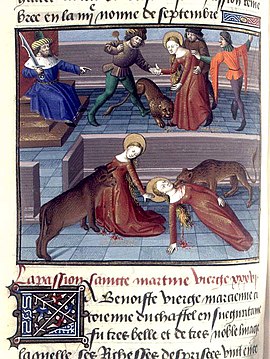Marciana of Toledo
Saint Marciana | |
|---|---|
 The Martyrdom of Saint Marciana. 15th century French manuscript. | |
| Martyr | |
| Died | 304 Caesarea, Mauretania Caesariensis |
| Venerated in | Roman Catholic Church |
| Feast | January 9 |
| Attributes | sometimes depicted with a leopard and bull near her[1] |
| Patronage | invoked to cure wounds |
Marciana of Toledo, also known as Marciana of Mauretania and Marciana of Caesarea,[2] (died 9 January 304)[3] is venerated as a martyr and saint.
Veneration
[edit]Her feast day is celebrated by both the Roman Catholic Church and the Eastern Orthodox Church on July 12.[4] In some early calendars, her feast day is celebrated on January 9.[5]
The Mozarabic office has a special hymn in her honor.[6]
Life
[edit]According to Alban Butler, Marciana was a native of Rusuccur in Mauretania, in modern day Algeria.[7][8]
Historian Brent Shaw states that her legend emphasized her virginity and commitment to asceticism, and contained "a new kind of hostility that was added to the old story of Christian-pagan hatreds".[3] According to her story, Marciana was a devout young Christian woman "so filled with zeal for her new faith"[3] that she left her family home to reside in Caesarea, approximately 80 miles east of their home and "immediately displayed an aggressive hostility to traditional forms of civic religion".[3]
She abhorred the worldly benefits of a high social status and she put aside her worldly riches. She traveled to Caesarea, Mauretania (modern-day Algeria) and took up residence in a cave in order to preserve her virginity (for she was said to be very beautiful) and consecrated herself to God through various exercises in fasts and other practices of self-deprivation that were used in lieu of martyrdom. Caesarea was by that time occupied by the Roman Empire under the Emperor Diocletian[9] (284-305 A.D.[10]).
Martyrdom
[edit]Marciana's martyrdom occurred during the Diocletianic Persecution. The Latin account of her martyrdom was written possibly in the 5th century.[11] Shaw states that she led an "aggressive anti-idolatry campaign".[3] While walking in the public square, Marciana attacked a statue of the Roman goddess Diana, tearing the head off and smashing the body to pieces.[9] The local citizens had her arrested and brought her before the governor's tribunal for punishment.[12] She was imprisoned in the local gladiatorial school, which Shaw states was "a brutal test"[13] of her sexual purity. Marciana was then punished by being thrown in the local arena, where she was mangled by a bull. After her death, a leopard was sent in and it snapped her neck.[13]
Marciana died in Caesarea, Mauretania Caesariensis.[3] Her relics were moved to Toledo, which led to her being known as "Marciana of Toledo." [14]
Shaw states that Marciana's story demonstrates the conflict between the Christian and Jewish communities in Caesarea during the period and was part of the "long and well-developed” anti-Jewish literature of the time.[15] Shaw cautions, however, that narratives like this, that directly include Jews in the persecution of Christians in Africa during the 4th and 5th centuries, were "exceedingly rare".[15]
See also
[edit]References
[edit]- ^ Husenbeth, Frederik Charles. Emblems of Saints: By which They are Distinguished in Works of Art, Longman, Green, Longman, and Roberts, 1860, p. 108
- ^ Gordini, Gian Domenico. "Marciana di Cesarea di Mauritania", Santi e Beati, October 9, 2002
- ^ a b c d e f Shaw, Brent D. (2011). Sacred Violence: African Christians and Sectarian Hatred in the Age of Augustine. Cambridge, Massachusetts: Cambridge University Press. ISBN 9780521127257. p. 265
- ^ Phillips, Fr Andrew. "Latin Saints of the Orthodox Patriarchate of Rome". www.orthodoxengland.org.uk.
- ^ https://catholic.net/plugins/convertpdf/docs/articulos.php?id=2583
- ^ Odden, Per Einer. "Den hellige Marciana av Mauretania (d. 303)", Den katolske kirke, December 15, 1997
- ^ Butler, Alban. "St. Marciana, Virgin and Martyr", The Lives of the Saints. 1866
- ^ Morcelli, Stefano Antonio. Africa christiana, Volume I, Brescia 1816, p. 268
- ^ a b "St. Marciana of Spain - Antiochian Orthodox Christian Archdiocese". www.antiochian.org.
- ^ "Diocletian | Biography, Empire, Definition, Persecution, & Reign | Britannica". www.britannica.com. 6 May 2023. Retrieved 30 May 2023.
- ^ "Record | The Cult of Saints". csla.history.ox.ac.uk. Retrieved 14 February 2023.
- ^ Shaw, pp. 265–266.
- ^ a b Shaw, p. 266
- ^ Watkins, Basil. The Book of Saints: A Comprehensive Biographical Dictionary, Bloomsbury Publishing, 2015, p. 463 ISBN 9780567664150
- ^ a b Shaw, p. 267
- 303 deaths
- 4th-century Roman women
- 4th-century Romans
- 4th-century Christian martyrs
- Deaths due to bull attacks
- Deaths due to leopard attacks
- Executed ancient Roman women
- Female criminals
- Late Ancient Christian female saints
- People executed by the Roman Empire
- Saints from Mauretania Caesariensis
- Spanish saints
- 4th-century deaths
- Virgin martyrs
